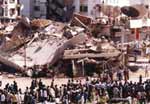India's Worst Quake in 50 Years Leaves 2,250 Dead, More MissingThe quake, also felt in Pakistan and Nepal, cast a tragic shadow over India's annual Republic Day celebrations and was described as a "calamity of national magnitude" by Prime Minister Atal Behari Vajpayee. Indian officials measured the quake's magnitude at 6.9 on the Richter scale, but foreign seismologists put it at up to 7.9. The quake struck at 8:46 am (0316 GMT) with the epicenter located 20 kilometers (12 miles) northeast of the medieval Guajarati town of Bhuj. PTI said more than 1,000 people were reported killed in Bhuj -- the epicenter of the quake -- with 5,000 people either "missing or trapped in the rubble." "The toll is likely to go up once the debris is cleared," it said. Officials said communication lines went dead and people were out in the streets fearing further tremors. PTI put the total death toll at more than 2,250 with about 300 people dead in coastal Gujarat's main city of Ahmedabad and 150 people dead in Rajkot, 250 kilometres (155 miles) west of Ahmedabad. Jamnagar, Surendranagar and Patan, all adjoining Rajkot, accounted for more than 170 people dead. The agency did not give a breakdown for the rest of the death toll. Witnesses said the only hospital in Bhuj was jampacked with patients, mostly with fractured bones. "There are very few doctors around to help us. Air Force relief teams are still coming in. We have only three to four doctors attending to hundreds of patients pouring in," a resident said. A government official told AFP that in Bhuj's neighbouring town of Anjar, about 650 people were reported dead with the "main bridge connecting Bhuj totally destroyed." "This has been a major drawback in relief operations," he said. Cabinet spokesman Pramod Mahajan put the number of confirmed dead in Gujarat at 651, but added the toll "could be higher," while Home Minister L.K. Advani, who flew to Ahmedabad from New Delhi put the figure at "1,000 or more." Officials in Ahmedabad said hundreds of people were believed to be trapped in the rubble of buildings that simply folded in on themselves when the quake hit. Seismologists recorded more than 80 aftershocks, one of which measured 5.6 on the Richter scale. The army, air force and navy were all brought in to help relief operations, with Advani ordering two army battalions to the affected areas. Floodlights had been set up in Ahmedabad to help relief workers using long iron crowbars and their bare hands to prise away rubble from demolished buildings. The evening temperature was around seven degrees centigrade and special army posts had been set up to distribute blankets and first aid. "There have been some tragic incidents. Like a school which collapsed, trapping at least 30 students," said an official at the city's relief control room. Gujarat is one of India's economic powerhouses and home to the country's largest petroleum refinery, which was undamaged. The state is earthquake-prone, but cost-cutting means that buildings are rarely designed to withstand quakes and officials said many of collapses were of new high-rises. An air force base in Bhuj was also badly hit. "We are still assessing the total damage, but there has been loss of life and property," said Air Force spokesman R.K. Dhingra. Doctor Vikram Parjhi, head of casualty at Ahmedabad's main civil hospital, said his team had received hundreds of casualties. "Sixty-four of those were dead on arrival," Parjhi said, adding most of those treated suffered head injuries and fractures. The quake struck barely one hour before the Republic Day parade in New Delhi. "I am deeply pained and distressed to know about the devastating earthquake," Prime Minister Vajpayee said in a statement, and put government aid agencies on a war-footing to help the victims. Tremors were felt across central and northern India, in New Delhi and Bombay, as well as Madras and Pondicherry in the southern state of Tamil Nadu and in the eastern metropolis of Calcutta. In Pakistan at least ten people were killed as the quake rocked major cities. The last big earthquake to hit India was in March 1999. Measuring 6.8 on the Richter scale, it killed 100 people in the Himalayan foothills. Friday's was the largest since a quake registering 8.5 struck the northeastern state of Assam in 1950, killing 532 people. |
| People's Daily Online --- http://english.peopledaily.com.cn/ |
